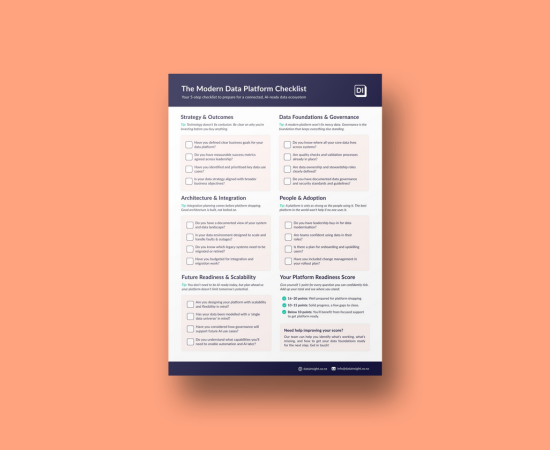How many times have you been in a meeting where different people have reported different numbers on the same subject?
Or questioned metrics in a report because they seem so far off reality?
You’re certainly not alone and unsurprisingly, it’s these types of situations that erode the trust people have in data. But trusting data is critical because it’s central to making informed decisions and is utilised in the tools and technology that underpin business operations. Furthermore, the significant benefits of operating a data-driven businessare widely understood and is why digital transformation is a prioritised deliverable in many a board paper.
What causes data challenges?
It would be easy to blame technology, but in reality, most of these issues stem from complexities relating to people, processes, and governance. At a high level, these include:
- A lack of accountability of the elements being reported on, which can be due to:
-No source of truth for each element
-Unclear definitions of the elements
-Different methods used to calculate a metric - Existing information and reports not being easily accessible
- Fragmented or lack of engagement between technical teams during the solution development process
- Informal or lack of review process to ensure information accuracy
- Unclear view of information sources
To run a truly data-centric business, addressing these foundational challenges must be undertaken to ensure data is clean, current, relevant, and therefore trustworthy.
Start at the very beginning
The first step is to clearly outline the outcome the business wants to achieve, and then undertake a discovery process to assess the level of maturity within the business. This involves a holistic approach that benchmarks technology, people, and processes against best practice to identify where the business currently sits on the maturity scale, and what’s required to achieve the desired goal. This will involve different stakeholders across the business to uncover recurrent issues and opportunities, as well as identify any good practices currently performed in isolation that could be leveraged.
The goal set at the beginning of the process plays a critical role in ensuring there is a focused approach on achieving the intended outcome. The process will also surface the impact of current challenges, where there are gaps, efforts that have been unsuccessful previously and the reasons why (to avoid any repetition).
Continue to seek feedback from stakeholders throughout the process to ensure insights gained during the discovery process align with their views, and to help prioritise remedial work and opportunities based on complexity and value to the business. As those on the ground and running the day-to-day, these people should have in-depth knowledge on these aspects. One cautionary note, however, is that while it can be tempting (and exciting) to jump into designing future stages, getting the foundations right and well embedded is an essential first piece of work that must be undertaken. At Data Insight, we recommend taking a gradual approach, starting small in key areas.
This approach you will enable you to:
- Obtain some early learnings and refine actions to be taken before rolling them out to other parts of the business
- Have real use cases and tangible benefits to present to other stakeholders to obtain their buy-in
Drive change from the top of the business
The changes required to enable a data-centric business will likely impact most areas, and therefore must be driven from the leadership team. This will filter through the company via the actions of key stakeholders in both technology and business teams.
Depending on the size of the business, it is usually a Chief Data Officer who will assess the cost and availability of resources to execute the required workstreams (both financial investment as well as time) to ensure the roadmap is feasible.
They will also manage delivery of the programme of work, engaging with different business areas and leaders to provide support and guidance on delivering the actions required. There will likely be new systems or technology required, which can be lengthy and costly, albeit bringing huge benefits.
Before commencing, we recommend you work with a vendor, or employ the skills in house to:
- gain a clear understanding of the challenges to be solved to identify requirements of any new systems
- develop processes to ensure the right use of data
- establish the right data foundations to enable ongoing analysis
- establish a change management programme to support the achievement of the desired state (your programme should address the areas you have identified during your assessment as critical, with initiatives to support achieving your desired state)
The future is in data
Setting goals, undertaking a business maturity assessment, and executing a programme of change may sound daunting, especially if your business does not have the capability and tools in-house. However, the benefits to harnessing data and technology to inform decisions and drive business operations will far outweigh any burden of the transformation process and will ensure your business is geared towards the future.









.png)